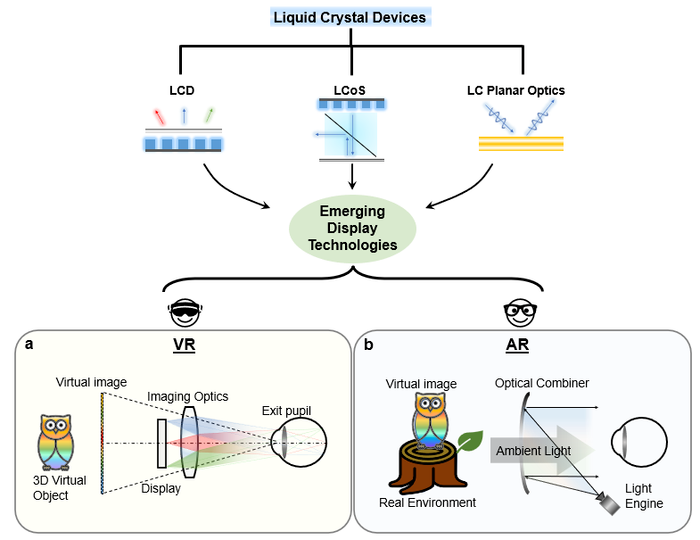Virtual reality (VR) and augmented reality (AR) have the power to change how humans perceive and interact with digital data. Since the 1990s, AR and VR have seen a surge in popularity, entering a new era of display and information networks. On one end of the range is a virtual reality (VR) display, which significantly expands the field of view (FoV), blocks out the entire surroundings, and provides a fully immersive virtual environment.

Top figure illustrates advanced LC-based devices, including LCD, LCoS, and LC planar optics. These LC devices contribute to novel display technologies, including AR and VR systems. The bottom figure shows the system configurations of a, VR and b, AR. Image Credit: Kun Yin, En-Lin Hsiang, Junyu Zou, Yannanqi Li, Zhiyong Yang, Qian Yang, Po-Cheng Lai, Chih-Lung Lin, and Shin-Tson Wu.
AR display, on the other hand, allows for see-through capability while overlaying digital content onto the actual world. AR/VR displays have opened a new door for a variety of applications, like medicine, education, engineering, manufacturing, and entertainment, to mention a few.
These new display platforms are combined with newly developed functional LC-based optics to create a slew of remarkable AR/VR-ready LC devices. Due to the different capabilities, specific demands, and quick growth of LC devices in near-eye systems, it is becoming increasingly vital to describe sophisticated LC-based devices in AR/VR from a complete perspective in order to give a helpful reference for future evolution.
A group of researchers led by Professor Shin-Tson Wu of the University of Central Florida’s College of Optics and Photonics performed a thorough and structured analysis to define various functional LC devices with their corresponding applications in near-eye displays. The study was published in Light Science & Applications.
Three key LC devices are presented in-depth in this paper: transmissive active matrix microdisplays, reflective Liquid-Crystal-on-Silicon (LCoS), and LC planar optics. Figure 1 depicts the categorization of LC photonic devices, as well as their architectures and operating principles, which are widely employed in AR/VR systems as developing technologies to serve a variety of functions.
In particular, low transmittance issues due to minor aperture ratios and declination lines blocking the backlight plague high-dynamic-range (HDR) LCDs for VR headsets. Accomplishing a high-performing VR that is compatible with directional backlight and spatially shaped beam steerer offers a viable alternative.
Meanwhile, LCoS spatial light modulators provide unparalleled phase modulation for near-eye systems to produce holographic visions beyond traditional displays. With an ultrathin form factor and high performance, developing LC planar optics have remarkable optical qualities.
These sophisticated LC devices encompass the full AR/VR system, from light engines to imaging optics to optical combiners, and play critical roles in systematically improving the picture quality and form factor of AR/VR displays.
Wu and colleagues described their findings as an outline of LC devices in the rapidly increasing field of AR/VR systems. Various devices, such as HDR and high-resolution density microdisplays for VR, high-brightness and high-resolution LCoS light engines for AR, and polarization selective beam deflector and lens, are presented using sophisticated LC as the foundation.
Wu’s team demonstrated numerous exciting photonic solutions to address these difficulties and provide beneficial guidance for effective LC device development based on the specific AR/VR requirements, like light efficiency, resolution density, ambient contrast ratio, form factor, imaging performance, FoV, and vergence-accommodation conflict.
Journal Reference:
Yin, K., et al. (2022) Advanced liquid crystal devices for augmented reality and virtual reality displays: principles and applications. Light: Science & Applications. doi.org/10.1038/s41377-022-00851-3.